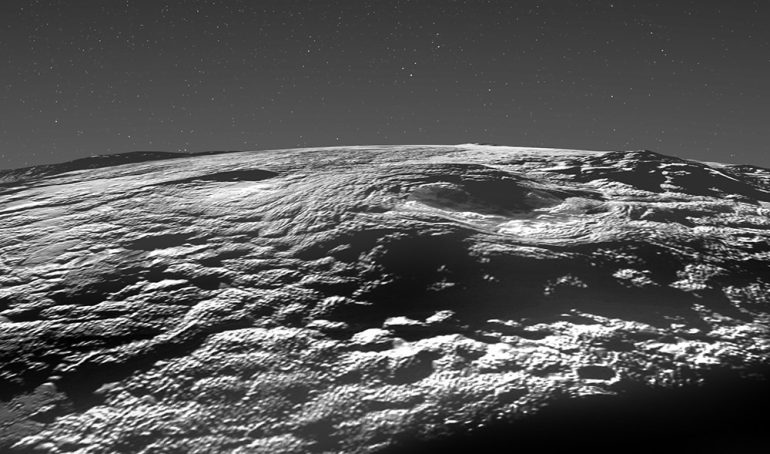Unique Event: An analysis of data from NASA’s New Horizons spacecraft suggests a never-before-seen form of ice volcano on the dwarf planet Pluto. Slowly escaping, viscous water ice over time piled up mountains up to seven kilometers high, creating ice volcanoes whose volume is greater than the largest fiery mountains on Earth. The young age of some of these structures also suggests that Pluto may still be hot from the inside.
dwarf planet Pluto Despite its distance from the Sun and freezing temperatures, the world is surprisingly dynamic, as shown by images from NASA’s New Horizons spacecraft. There are glaciers flowing over it, which are shaped like upturned currents ice floes and also winch, driven by the exit of frozen nitrogen from the great ice sheet Sputnik Planitia. Surface stretch marks and planetary models also suggest that Pluto’s interior is still warm enough for a subglacial ocean Or at least the ice layers can be softened.
Riddles about giants of the snowy mountain
But one question remains unanswered: Are there ice volcanoes on Pluto? This question is asked by two mountains with large craters in their peaks, located to the south-west of the Sputnik Planitia ice field. Along with Wright Mons, which is about five kilometers high and about 150 kilometers wide at the base, this summit depression also has a diameter of 56 kilometers. In early 2015, the shape of these mountains woke up Doubtthat these may be ice volcanoes – vents that bring half-melted ice to the surface.
Kelsey Singer of the Southwest Research Institute in Boulder and her colleagues have now looked again for evidence of such cryovolcanism on Pluto in data and images from the New Horizons probe. To do this, they mainly analyzed images in which potential ice volcanoes were conspicuously illuminated by weak sunlight, so that surface structures clearly stood out because of shadows.
Unlike known volcanic forms
The result: volcanoes and ice volcanoes at least in the classic sense do not resemble the Pluto mountains, as the team reports. The summit depressions of Wright Mons and Piccard Mons, which are more than seven kilometers high, are quite different from calderas or volcanic vents on Earth and Mars. According to Singer and his colleagues, among other things, the openings are very large and irregular in shape and do not match the later collapsed craters.
“Furthermore, there is no clear evidence of a directed flow or the location of the exit centers,” report the researchers. Traces of oozing material or exuded sputum are completely absent. It is also strange: the entire area of this region, including mountain ridges and crater depressions, is covered by lumpy elevations a few hundred meters high and up to 20 kilometers wide – this is also unusual for volcanoes and ice volcanoes.
The terrain is still relatively young
Singer and his team say, “The geological features of the Wright-Mons region are different from all other regions of Pluto and those of most other celestial bodies in the Solar System.” The almost complete absence of impact craters in this region also suggests that the landscape here is relatively young – it must have been reshaped long after the dwarf planet formed.
This is supported by late formation spectral data. Thus, the base material of these mountains consists of rock-hard frozen water ice covered by a thin cover of organic deposits and more volatile types of ice such as nitrogen ice and frozen methane. According to the researchers, differences in the thickness and composition of these layers suggest that different regions of the region did not form together, but are of different ages.
Novel form of cryovolcanism
But how does it all fit together? According to the research team, the Wright and Piccard Mons and the area between them may have formed from a novel form of cryovolcanism. In the process, hard but still mobile water ice rose up through several cracks in the subsurface and formed a dome-like elevation. Over time, these individual domes merged into the mountainous landscape seen today.
Singer and his colleagues wrote, “This scenario provides a coherent explanatory mechanism for all major peaks and troughs—both dome-shaped or ring-shaped and more complex.” The two high mountains were formed because there were several ice outcrops close together and were constantly pushing up new masses of water ice from below. This resulted in major upgrades such as Wright Mons and the even larger Piccard Mons.
“The volume of Wright Mons alone is 24,000 cubic kilometers – this is similar to the volume of Mauna Loa in Hawaii,” explained the researchers.
Sign of internal heat?
If this scenario is confirmed, the dwarf planet Pluto could have a unique form of ice volcanism. Plus, it also means that Pluto is actually hotter inside than long thought. Because this heat is a prerequisite for water ice to become mobile enough to come to the surface at least slowly.
“The extremely low temperature, low atmospheric pressure, low gravity outflow of icy material on the surface of the celestial body, combined with the abundance of volatile ice on the surface of Pluto, makes it unique among any previously discovered locations in the solar system,” Scientists say. (Nature Communications, 2022; doi: 10.1038/s41467-022-29056-3,
Source: Nature Communications

Internet fan. Alcohol expert. Beer ninja. Organizer. Certified tv specialist. Explorer. Social media nerd.





